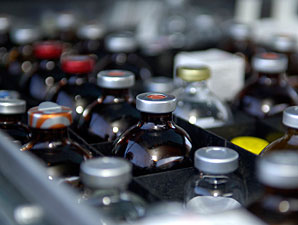RMTC Board Changes Three Drug Thresholds


At its Feb. 23 meeting at Gulfstream Park, the Racing Medication and Testing Consortium board voted to revise thresholds for three medications on the list of controlled therapeutic substances and recommended expanding out-of-competition testing that would include a list of prohibited substances.
The actions followed recommendations from the RMTC's Scientific Advisory Committee and Horseracing Testing Laboratories Committee.
Based on recently completed research, RMTC board members unanimously approved revised thresholds for xylazine and detomidine (two sedative/analgesic medications) and omeprazole (an anti-ulcer medication). Research for these substances was performed at the UC Davis Maddy Lab, Kentucky Equine Research, and the University of Florida. The thresholds and withdrawal guidance for these substances can be found on the CTS list page of the RMTC website.
The changes saw the threshold for xylazine go from 10 picograms per millliter of serum to 200 picograms per milliliter. Also, there previously was no advice on the experimental administration dosage; that has been changed to 200 milligrams (intravenous). The withdrawal guideline didn't change; it stays at 48 hours.
The threshold for detomidine was changed from level of detection to 1ng/ml in blood. For testing of urine, the threshold recommendation was changed from 1ng/ml to 2 ng/ml. The withdrawal guideline was changed from 72 hours to 48 hours for dosage of 5mg (intravenous). The previous experimental administration dosage was 40mcg/KG (sublingual).
The previous threshold guidance for omeprazole was for urine testing, at 1 ng/ml. The new threshold is based on blood testing and is set at 10ng/ml. The withdrawal guideline didn't change. The experimental administration dosage did change, from 3.9 mg/kg orally to 2.2 grams (orally) once daily for four days.
"The CTS list is a living document, as evidenced by the addition of a number of medications since it was first enacted," stated RMTC executive director Dr. Dionne Benson. "In this instance, the RMTC and its stakeholders, through the SAC process, revised three historic regulatory thresholds by funding and executing scientific research to ensure horsemen had the best information available to make decisions."
In addition, RMTC board members voted unanimously to recommend to the Association of Racing Commissioners International an expanded and more comprehensive out-of-competition testing rule for horse racing. The recommended model rule addresses sampling procedures and defines what substances are prohibited in a prohibited substance list. The list is modeled on the World Anti-Doping Agency prohibited substances list -taking into account substances unique to equine health under specified conditions.
"The proposed model rule including the prohibited substance list will provide horse racing an out-of-competition program that is second to none in professional sports," stated Dr. Benson. "By enacting this rule, we go beyond protecting against just blood doping agents to proactively protecting the health and welfare of the race horse everyday - not just on race day."
The RMTC will present the revised threshold recommendations, out-of competition model rule proposal, and prohibited substance list to the RCI and will advocate for their inclusion in the RCI model rules.
Also as the February meeting, RMTC chair Alex Waldrop updated the board on significant progress toward full adoption of the National Uniform Medication Program. According to Waldrop, the controlled therapeutic substances list has now been adopted in 18 states representing more than 90% of total handle, third-party veterinarian administration of furosemide has been adopted in 17 states representing 65% of total handle, the multiple medication violations penalty system has been adopted in 12 states representing 35% of total handle, and 28 states representing more than 75% of total handle are now receiving testing services from RMTC-accredited and soon-to-be accredited laboratories.
"We expect to see at least half the racing states fully adopt the National Uniform Medication Program by the end of the year," said Waldrop. "We will get to a point soon where non-compliant states will be faced with the choice of either joining the program or risk being ostracized by racing fans and participants alike."
In addition, the board:
• Approved screening limit recommendations for various environmental contaminants to match environmental residue screening limits used in international horse racing;
• Granted full accreditation status to the Texas A&M Veterinary Medical Diagnostic Laboratory and, Interim Accreditation status to the New York Drug Testing and Research Laboratory - the eighth laboratory to receive RMTC accreditation; and
• Approved a split sample submission program for regulators and laboratories to simplify and improve communication in the split sample process.
